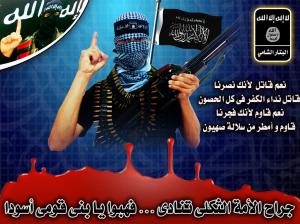
Clearly intended for the purpose of recruitment, the dominant element in the image is the bottom caption, which against the dripping pool of blood reads: “jarah al-umma al-thakla tunadi…fa-habu ya bani qawmi usudan” (“the injuries of a bereaved nation call out…so grant [me] lions [fighters], O my people”). The text on the left tries to further appeal to new recruits: “ni‘ma qatil, li-annaka nasruna, qatil nida’ al-kufr fi kull al-husun; ni‘ma qawim, li-annaka fajruna, qawim wa-amtir min sulalat sahyun” (“What an excellent warrior you are! Because you are our victory, fight the call of infidelity in every stronghold; what an excellent fighter you are! Because you are our daybreak [i.e., new beginning], fight and rain out the scions of Zion”).
The armed figure in the center is raising his right index finger in a motion carried out during the utterance of the shahada (Islamic testimony of faith holding that there is no god but Allah and that Muhammad is his messenger), which is spelled out in the image no less than five times: in the top right logo, on the black banner behind the center armed fighter, on his black head scarf, and twice in top left picture. On the black flag behind the armed fighter appears an additional caption, which is a partial quote from Qur’anic verse 3:160: “in yansurukum Allah fa-la ghaliba lakum” (“if God assists you, there is no one who would be victorious over you”). The logo in the top right has an interesting twist to it. While it appears to be the logo of the Islamic State of Iraq (ISI)/al-Qa’ida in Iraq (AQI)/Jama’at al-Tawhid wal-Jihad (JTJ), at its bottom it bears the words: “al-battar al-shami” (“the Syrian sharp-edged sword”). This is likely a reference to the creator of the image.
The black banner behind the figure is significant because, according to prophetic tradition (hadith), the black flag was the battle flag of the Prophet Muhammad and it was carried into battle by many of his companions. The image of the black flag has been used as a symbol of religious revolt and engagement in battle (i.e., jihad). In the contemporary Islamist movement, the black flag with the shahada (Islamic testimony of faith holding that there is no god but Allah and that Muhammad is his messenger) is used to evoke notions of jihad and of reestablishing the Islamic Caliphate.
More Information
Group Name
AQI/JTJ
Group Type
Jihadist Group
Group Affiliation
AQ Affiliates / Associates
Dominant Colors
Blue, Red
Secondary Colors
Black, White
Language
Arabic
Isolated Phrases / Mottoes / Slogans
1) "jarah al-umma al-thakla tunadi ... fa-habu ya bani qawmi usudan" 2) ni`ma qatil, li-annaka nasruna, qatil nida' al-kufr fi kull al-husun; ni`ma qawim, li-annaka fajruna, qawim wa-amtir min sulalat sahyun 3) shahada 4) (Q 3:160) in yansurukum Allah fa-la ghaliba lakum
Image Number
0327
Groups Region of Operation
Middle East
Groups Country of Operation
Iraq
Weapons
Firearms, Automatic / Assault Rifle, AK47, Ammo Belt / Vest
Body Parts
Pointer Finger, Blood, Face / Bust
Body Parts Analysis
Covered Face.
Liquid
Drops / Tear
Fire
Light Rays / Light
Geopolitical Symbols
Non-country Flag, Symbol of party, movement or company, Slogan
Geopolitical Analysis
Black flag with text of shahada. ISI/AQI and global jihad sympathizers logo - black flag bearing shahada that includes the seal of the Prophet; additional sub-group identifier indicated "al-battar al-shami."
People
Operative / Warrior (=mujahid), Man / Men
People Analysis
Armed fighter
Religious Textual References
Quranic Text, Quranic Citations
Religious Textual References Analysis
La ila illa Allah, Muhammad rasul Allah (including the seal of the Prophet)
Religious Symbols
Black / White / Green Banners, Seal of the Prophet
 Skip to content
Skip to content
